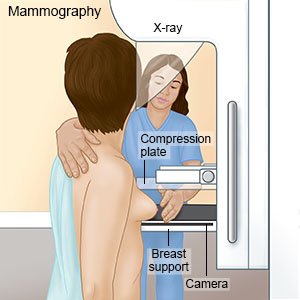Mammogram
Medically reviewed by Drugs.com. Last updated on Aug 4, 2025.
What do I need to know about a mammogram?
A mammogram is an x-ray used to diagnose or screen for breast cancer. Screening means you are checked regularly, even if you do not have signs of cancer. The timing for screening depends on your risk factors for breast cancer. Experts recommend a mammogram every 2 years from age 40 to 74 if you are at average risk. You may need to start earlier and get a yearly mammogram if you are at high risk. Mammograms are usually done every 1 to 2 years until age 74.
How do I prepare for a mammogram?
- Do not use deodorant, powder, lotion, or perfume. These products may cause particles to appear on your mammogram.
- Wear a 2-piece outfit.
- If your breasts are tender before your monthly period, do not have a mammogram during this time. Schedule your mammogram for 1 week after your period ends.
- If you are breastfeeding, express as much milk as possible before the mammogram.
- Bring a list of the dates and places of your past mammograms and other breast tests or treatments.
What will happen during a mammogram?
A top view and a side view x-ray are usually done for each breast. Tell healthcare providers if you have breast implants or breast problems before you have your mammogram. You may need extra x-rays of each breast.
- You will be given a hospital gown. Take off your clothes from the waist up. Wear the hospital gown so that it opens in the front.
- You will sit or stand next to a small x-ray machine. The healthcare provider will help you place one of your breasts on the x-ray plate. Your arm and breast will be moved until your breast is in the correct position.
- Your breast will be gently pressed between 2 plates for a few seconds while the x-ray is taken. This may be uncomfortable.
- You will be asked to hold your breath while the x-ray is taken. Another x-ray will be taken of the same breast after the position of the x-ray machine has been changed.
- Your other breast will be x-rayed the same way.
 |
What will happen after my mammogram?
Your breasts may feel tender for a short time after the mammogram. You may go back to your regular activities. Ask your healthcare provider when you should receive the results of your mammogram.
What are the risks of a mammogram?
You will be exposed to a small amount of radiation. Some breast cancers may not show up on mammograms. A mammogram may not find cancer if you have dense (thick) breast tissue. You may need more tests if you have dense tissue or are at high risk for breast cancer. Examples include an MRI, digital breast tomosynthesis (DBT), or ultrasound. Your provider can give you more information about these tests, if needed.
When should I call my doctor?
- You do not receive your results when expected.
- You have questions or concerns about the mammogram.
Care Agreement
You have the right to help plan your care. Learn about your health condition and how it may be treated. Discuss treatment options with your healthcare providers to decide what care you want to receive. You always have the right to refuse treatment. The above information is an educational aid only. It is not intended as medical advice for individual conditions or treatments. Talk to your doctor, nurse or pharmacist before following any medical regimen to see if it is safe and effective for you.© Copyright Merative 2025 Information is for End User's use only and may not be sold, redistributed or otherwise used for commercial purposes.
Further information
Always consult your healthcare provider to ensure the information displayed on this page applies to your personal circumstances.
